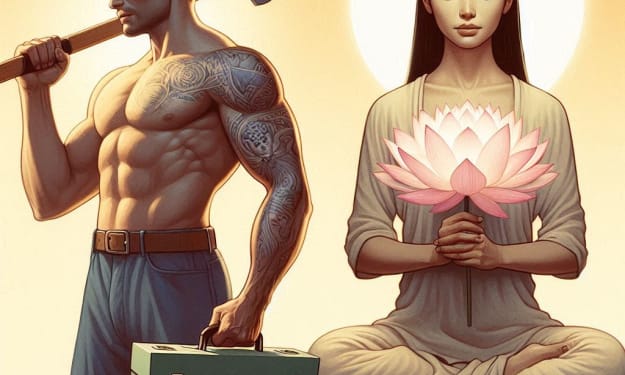An Exhaustive — and Exhausting — Guide to the Treatment of PMDD
Finding relief has required a multifaceted approach to symptoms

I breathed a literal sigh of relief when my doctor diagnosed me with Premenstrual Dysphoric Disorder, more commonly known as PMDD. I felt my entire body relax as I waited for her to tell me how she was going to fix it. It didn’t take long for disappointment and overwhelm to set in.
PMDD has no cure, and riding this hellish roller coaster until I finally hit menopause in another 10–15 years doesn’t seem possible. Clearly seeing my unease, the doctor slowly took me through both her differential diagnosis as well as the full list of treatment options.
Are you ready for them? It’s an exhaustive — and frankly, exhausting — list. I’ve been working my way down it, trying to find some relief from the onslaught of symptoms.
There’s a mistaken idea that PMDD is just really bad PMS. That’s sort of true but misses the mark entirely. PMDD is incredibly debilitating. It’s an invisible illness that can incapacitate sufferers for half of every single month. What’s worse is that it makes many of us feel crazy while we’re going through it.
Symptoms don’t just cover bloating, cramps, nausea, and headaches. Many of us also experience depression, heightened anxiety, suicide ideation, and low self-esteem. We can be completely fine until our cycle hits, and then we’re overcome by mood swings that feature limited impulse control.
Here are some of the ways I’ve been treating my PMDD symptoms based on advice from my doctor. Keep in mind: this is not medical advice. Consult your own physician or healthcare provider before beginning any of the following treatments.
Mental Health Therapy
When I first started lining up appointments, I included therapy. I had been experiencing periodic suicide ideation for nearly two years. The depression, anxiety, and mood swings were getting worse. For a few months, I attended weekly EMDR therapy sessions. EMDR stands for eye movement desensitization and reprocessing. While it often targets early trauma, I found that it also helped me handle my heightened emotions.
Therapy doesn’t just take place within each session. It continues with each coping skill I use and each technique I practice in the real world. It has taught me to be gentler with myself and less judgmental. I practice self-compassion on those days when I can do little more than curl myself around a heating pad and sleep, serving up Lunchables for dinner and letting my children watch hours of TV. I do what I can, and that is enough.
Birth Control
This one continues to be a struggle for me. I opted for an IUD, which is great if you like bleeding for a month straight and worsening mood swings. I decided after a few months of heavy bleeding and increased mood swings to discontinue the IUD. The last thing someone with PMDD needs is more hormonal disturbances and mood swings. However, birth control of some form or fashion has helped many sufferers of PMDD.
In fact, an IUD has been an effective treatment for some. Birth control isn’t a one-size-fits-all option. Many doctors recommend a birth control pill or other options to help treat some of the PMDD symptoms. While an IUD hasn’t worked for me, it just might work for you.
Replacing Feminine Hygiene Products
Because tampons and pads sometimes contain harmful chemicals, I’ve opted for two new products to manage my often heavy cycles: Flex discs and Thinx period underwear. There is an initial monetary investment for both of these products, but I have found that it makes more sense for me to opt for a reusable option over-investing in the near-lifetime supply of tampons. This may not seem like PMDD treatment, but anything that decreases cramping and contributes to feeling better is worth a try.
Antidepressants (SSRIs)
Even though I’m a former therapist, I haven’t always been a fan of antidepressants, but my doctor suggested that I try taking them cyclically. I take Sertraline (commonly known as Zoloft) during my luteal phase, beginning with the 14th day of my cycle, and continue it until the second or third day of my period. Not only does this limit side effects, studies have shown it’s just as effective as daily use for those suffering from PMDD. For those of us who experience heightened emotional disturbances each month, antidepressants can be an essential part of our treatment.
Nutritional Supplements
As a part of my treatment, I saw a naturopathy doctor. She recommended the following supplements for my treatment: daily magnesium supplements, daily iron supplements, daily taurine supplements, utrophin PMG, and Nevaton Forte. Keep in mind, each of these supplements was recommended specifically for my current symptoms. Here’s what they each do as a part of my treatment.
Magnesium can help with mood disturbances that come with PMDD.
Iron supplements can help avoid anemia, particularly with heavy bleeding that often accompanies PMDD. It can also help reduce the heaviness of the cycle.
Taurine is often paired with magnesium. Taurine can support the mood and help alleviate the anxiety. It has many health benefits and is often recommended for the treatment of hormonal issues.
Utrophin PMG provides uterine support and helps balance the hormones. While this was recommended by my naturopath, I didn't find it to help reduce my symptoms.
Nevaton Forte is an herbal supplement that supports balanced moods. It contains saffron, St. John’s Wort, Schisandra (a Chinese berry), and skullcap. As a side note, because taking St. John’s Wort is contraindicated when prescribed SSRIs, discuss this supplement (and any others) with a healthcare provider. Failure to do so can be life-threatening.
Chiropractic Adjustments
Regular chiropractic adjustments aren’t covered by my insurance, but they have helped bring relief, particularly in the heaviest part of my cycle. Regular alignment and adjustments have helped alleviate the discomfort caused by period cramps. I now consider this an essential part of my PMDD treatment.
Massage
Both regular massage and Thai massage have been lifesavers in my battle with the symptoms of this disorder. Because PMDD can cause fatigue, pain, and discomfort, massage can be a necessity rather than a luxury. On one of my worst cycles, I called a local spa for a last-minute appointment to help alleviate some of my pain.
Exercise
If I’m entirely honest, my exercise routine has suffered since my PMDD worsened. It may feel like the last thing in the world we want to do, but regular exercise can alleviate some of the symptoms. We just may want to opt for a lighter form if we feel incapable of any other.
I am a Peloton bike owner, and I’ve opted for more low impact and recovery rides during the worst phases. It gets me moving while taking into account my body pain and low energy levels. At first, I felt a sense of shame for being unable to keep up with my former daily exercise regimen, but I’ve learned to choose daily exercises that resonate with how I’m feeling.
Nutrition
The final component of my treatment has been nutrition. I’ve been given a list by my naturopathy of which foods will help support my cycles. Eating a pH diet can support my cycles, and the good news is that I don’t have to eat this way all the time. I just need to eat more high-alkaline foods during my cycle to help support a healthy hormone balance.
Are you exhausted reading this list? I often am. It’s extensive, but I’m slowly starting to feel some relief. I also use heating pads, take hot baths, and sleep quite a bit when I’m on the worst days. I’m practicing self-compassion because I often feel like my very worst self on the most challenging days. I’m loving myself through them and doing everything I can to stabilize my emotions and support the chronic pain that comes with the onset of my cycle.
There’s no cure, but with every step I take, I’m finding support. I’m talking to professionals who validate my struggle and help me find ways of managing it. The naturopathy clinic has even suggested that nutrition and supplements could help my body learn to balance itself, which means that there’s a chance that one day I won’t suffer from PMDD. It’s worth taking that chance in hopes of finding relief.
For so long, I didn’t know how to explain what was happening to me — the sudden drop in my mood, the strong and certain feeling of hopelessness, the nagging thoughts of suicide, the overwhelming fatigue, or the heightened pain. It made me feel crazy. It made me feel alone. It made me feel like my body was betraying me.
Now, I feel hopeful because I’m not alone. I’m just one of at least six million women who suffer from PMDD (1 in 20), and that number is likely underreported. I’m not alone because I have a full team of professionals who believe my diagnosis and are willing to do whatever they can to support it. It’s an exhausting and exhaustive treatment plan, but every day, it helps me feel better. It gives me some semblance of control over the chaos that was my life for a little while there.
If you’re one of the ones suffering, I hope it gives you a little hope, too. Look for professionals who won’t dismiss your concerns and who will offer you options for treatment that work for you. Know that you aren’t alone. You’re not crazy. It’s not just “bad PMS”. There’s help if you look for it, and it could make all the difference.
If you are experiencing suicidal thoughts, contact the National Suicide Prevention Lifeline at 1–800–273-TALK (8255) or text HELLO to 741741.
About the Creator
Crystal Jackson
Crystal Jackson is a former therapist turned author. Her work has been featured on Medium, Elite Daily, NewsBreak, Your Tango, and The Good Men Project. She is the author of the Heart of Madison series and 3 volumes of poetry.
Enjoyed the story? Support the Creator.
Subscribe for free to receive all their stories in your feed. You could also pledge your support or give them a one-off tip, letting them know you appreciate their work.






Comments
There are no comments for this story
Be the first to respond and start the conversation.